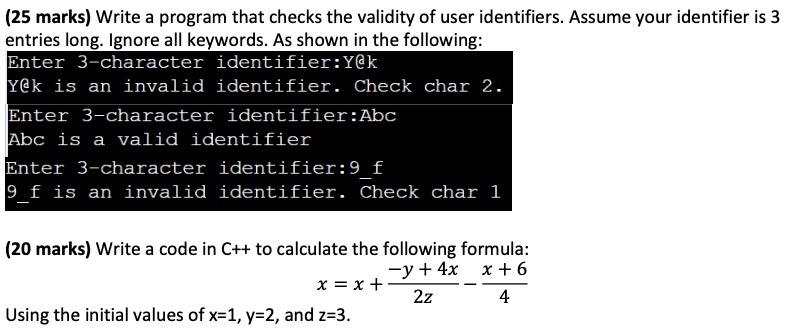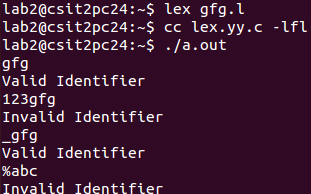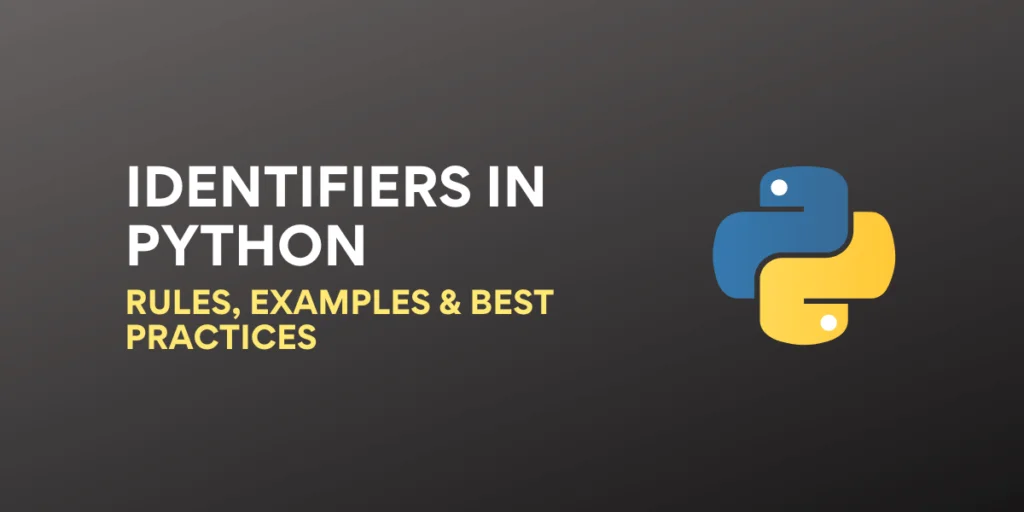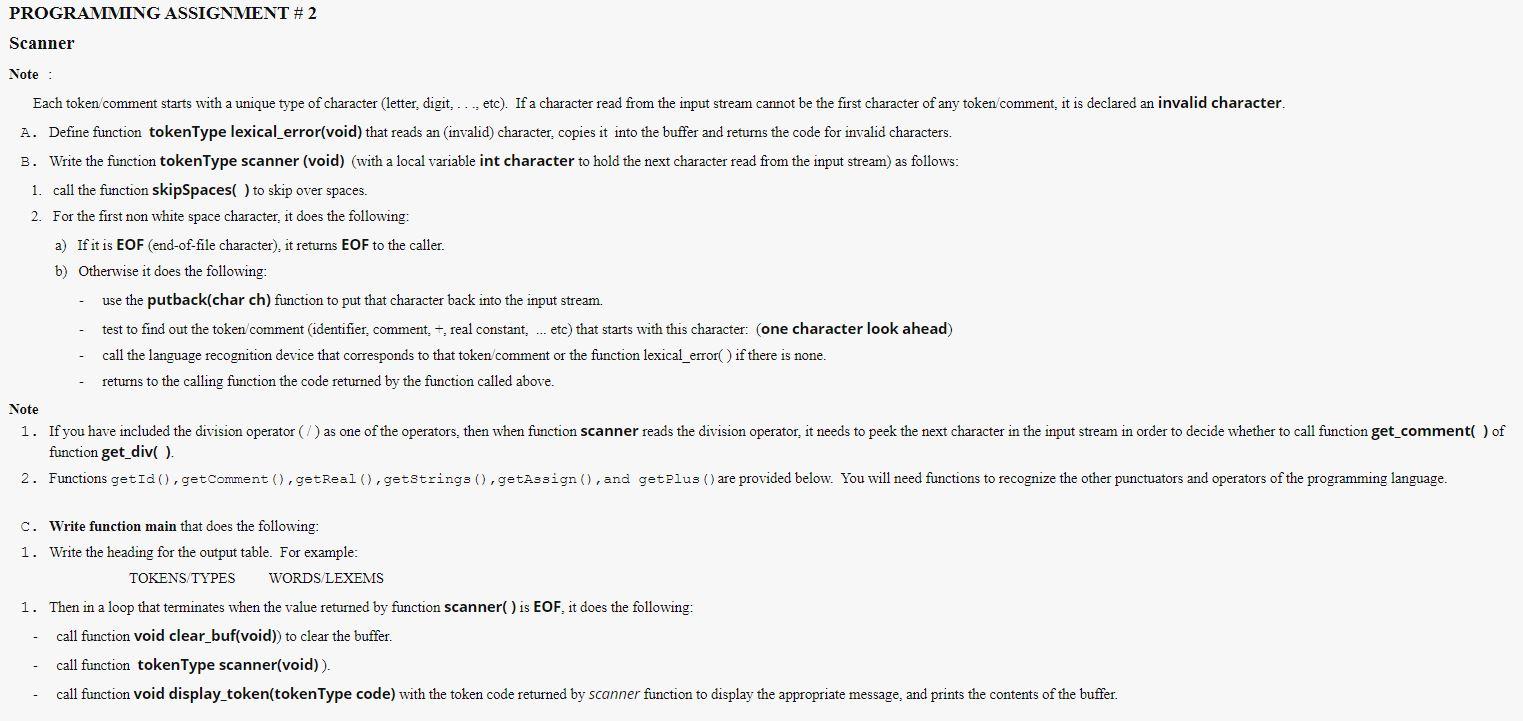Invalid Character In Identifier
An identifier is a name used to identify a variable, function, class, or any other program element in computer programming. Just like using proper grammar and syntax is crucial for effective communication, following the rules for identifiers is essential for writing clean and error-free code. One common issue that programmers encounter is the use of invalid characters in identifiers, which can result in errors and unexpected behavior. In this article, we will delve into the concept of invalid characters in identifiers, explore the reasons behind their importance, and provide best practices for using identifiers correctly. We will also address some frequently asked questions related to this topic.
What is an identifier?
In the world of programming, an identifier is a sequence of characters that is used to name variables, functions, or other entities. It serves as a unique identifier for a particular element within the program. Identifiers can contain letters (both uppercase and lowercase), digits, and underscores (_), but they must follow certain rules to be considered valid.
What characters are allowed in identifiers?
In most programming languages, the rules for valid identifiers are fairly consistent. A valid identifier can start with a letter (either uppercase or lowercase) or an underscore. Following the initial character, any combination of letters, digits, and underscores can be used. However, it is important to note that identifiers are case-sensitive, meaning that “variable” and “Variable” would be considered as two separate identifiers.
Why is it important to follow the rules for identifiers?
Following the rules for identifiers is crucial for several reasons:
1. Readability: Using meaningful and properly formatted identifiers enhances the readability of the code. It helps other programmers easily understand the purpose and functionality of different elements within the program.
2. Maintainability: Writing code that adheres to the rules for identifiers makes it easier to maintain and update the code in the future. It reduces the chances of introducing errors or confusion when modifying the codebase.
3. Compatibility: Different programming languages have their own set of rules for identifiers. By following the standard conventions, your code will be more compatible with other systems and frameworks.
What happens when an invalid character is used in an identifier?
When an invalid character is used in an identifier, it can lead to syntax errors or unexpected behavior in the program. For example, in Python, using an invalid character such as a hyphen (-) in an identifier would result in a “SyntaxError: invalid character” message, indicating that the code failed to compile.
Here are a few examples of common invalid characters that may result in errors:
– SyntaxError invalid character u 2013 in Python: The character u+2013 represents an en dash, which is not allowed in identifiers. Using it would trigger a syntax error in Python.
– SyntaxError invalid character U 2018: The character U+2018 represents a left single quotation mark, which is also not a valid character for identifiers. If included, it will raise a syntax error.
– SyntaxError invalid non-printable character U 200B: The character U+200B represents a zero-width space, which is a non-printable character. Adding it to an identifier would cause a syntax error.
– SyntaxError invalid non-printable character u 202a: The character u+202a represents a left-to-right embedding, which is another non-printable character. Using it in an identifier would result in a syntax error.
How can an invalid character in an identifier be avoided?
To avoid using invalid characters in identifiers, it is important to be aware of the rules and conventions of the programming language you are using. Here are some best practices to keep in mind:
1. Follow the right naming conventions: Different programming languages have different naming conventions. For example, in Python, it is recommended to use lowercase letters and underscores for variable names (e.g., my_variable). Understanding and adhering to the naming conventions of your chosen language will help you avoid invalid characters in identifiers.
2. Be consistent: Consistency is key when it comes to naming identifiers. Stick to a specific pattern and avoid mixing different naming conventions within your codebase. This will minimize the chances of inadvertently introducing invalid characters.
3. Use descriptive names: Choose meaningful and descriptive names for your identifiers to enhance code readability. By doing so, you can reduce the likelihood of using invalid characters when naming your variables, functions, or classes.
Common mistakes to avoid when using identifiers
While the rules for identifiers may seem simple and straightforward, programmers often make mistakes that lead to invalid characters. Here are some common errors to avoid:
1. Starting an identifier with a digit: Most programming languages do not allow identifiers to start with a digit. For example, naming a variable “2name” would be invalid.
2. Using reserved keywords: Programming languages have reserved words that cannot be used as identifiers. Attempting to use these words would result in an error. It’s important to familiarize yourself with the list of reserved keywords for your chosen language and avoid using them as identifiers.
3. Including spaces or special characters: Spaces and special characters (such as @, $, *, etc.) are not allowed in identifiers. Stick to alphanumeric characters and underscores to ensure your identifiers are valid.
Best practices for using identifiers correctly
To ensure that your identifiers are valid and adhere to best practices, consider implementing the following guidelines:
1. Choose descriptive and meaningful names: Use names that clearly convey the purpose and functionality of the variable, function, or class being defined. This will make your code more readable and maintainable.
2. Be consistent with your naming conventions: Adopt a naming convention and stick to it throughout your codebase. Whether you prefer camel case, snake case, or any other convention, consistency is key.
3. Avoid excessively long identifiers: While descriptive names are important, excessively long identifiers can make the code harder to read. Strike a balance between clarity and conciseness.
4. Use comments when necessary: If the purpose or functionality of an identifier is not immediately obvious, consider adding comments to clarify its usage. This will help other developers understand your code more easily and reduce the chance of misinterpretation.
FAQs
Q: What is the difference between an illegal character and an invalid character in an identifier?
A: An illegal character is one that is explicitly disallowed by the programming language. It cannot be used under any circumstances. On the other hand, an invalid character refers to a character that is not allowed within an identifier but may have other valid uses within the language.
Q: How can I identify if an identifier contains invalid characters?
A: Most modern code editors and integrated development environments (IDEs) will provide real-time feedback if you attempt to use an invalid character in an identifier. The editor may highlight the character or show an error message that indicates the presence of an invalid character.
Q: Can using invalid characters in identifiers cause security vulnerabilities?
A: While using invalid characters in identifiers does not directly lead to security vulnerabilities, it can make the code more difficult to read and maintain. This can indirectly contribute to security issues if it introduces confusion or misunderstandings when modifying or debugging the code.
Q: Are invalid characters the same across all programming languages?
A: No, the rules and restrictions for identifiers can vary between programming languages. It is important to consult the documentation or language specifications of the specific language you are using to understand the valid and invalid characters for identifiers.
In conclusion, understanding the importance of valid characters in identifiers is essential for producing clean and error-free code. By following the rules and best practices, you can ensure that your identifiers are meaningful, readable, and compatible with the programming language you are using. By avoiding common mistakes and adhering to conventions, you will ultimately enhance the maintainability and efficiency of your code.
Python : Invalid Character In Identifier
Keywords searched by users: invalid character in identifier Syntaxerror invalid character u 2013 python, invalid non-printable character u+00a0, SyntaxError invalid character U 2018, SyntaxError invalid non printable character U 200B, Syntaxerror invalid non printable character u 202a, Invalid non printable character U+FEFF, Invalid syntax Python, Illegal character
Categories: Top 67 Invalid Character In Identifier
See more here: nhanvietluanvan.com
Syntaxerror Invalid Character U 2013 Python
Python is a powerful programming language that has gained massive popularity due to its simplicity and versatility. However, like any other programming language, Python is not immune to errors. One such error that programmers often encounter is the SyntaxError: Invalid character ‘\u2013’. This error occurs when the Python interpreter encounters an invalid character, specifically the Unicode character ‘\u2013’, also known as the en dash.
The en dash (–) is a typographic symbol commonly used to represent a range of values or to indicate a connection between two elements. It is often mistakenly used by programmers when they intend to use a hyphen (-) or a minus sign (–). The en dash is not recognized as a valid character in Python syntax, resulting in a SyntaxError.
To better understand and fix this error, let’s explore some common questions and answers related to the SyntaxError: Invalid character ‘\u2013’ in Python.
FAQs about SyntaxError: Invalid character ‘\u2013’ in Python
Q: What causes the SyntaxError: Invalid character ‘\u2013’ in Python?
A: This error occurs when the Python interpreter encounters the en dash (–) character in the code, which is not recognized as a valid character in Python syntax. It is essential to use a hyphen (-) or a minus sign (–) instead of an en dash.
Q: Are there any specific circumstances in which this error occurs?
A: This error can occur in various situations where an en dash character is incorrectly used. For example, when defining variable names, specifying range boundaries, or as part of strings. It is vital to ensure that the correct character is used based on the intended purpose.
Q: How can I fix the SyntaxError: Invalid character ‘\u2013’?
A: To fix this error, simply replace the en dash (–) with the appropriate character. If you intended to use a hyphen (-), replace the en dash with a hyphen. If you intended to use a minus sign (–), replace the en dash with a minus sign.
Q: Can there be other characters that result in a similar SyntaxError?
A: Yes, the Python interpreter is strict about invalid characters. Apart from the en dash, other characters might cause the same error. For example, curly quotes (“ ” or ‘ ’), non-breaking spaces ( ), or other non-standard characters. Always ensure that you use valid characters based on the Python syntax.
Q: How can I avoid encountering this error in the future?
A: The best approach to avoid encountering the SyntaxError: Invalid character ‘\u2013’ is to be mindful of the characters you use in your code. Stick to the standard ASCII characters or characters recognized by the Python syntax. Favor conventional hyphens, minus signs, and quotes over their fancier counterparts.
Q: Can this error occur in other programming languages besides Python?
A: While this specific error is related to Python, other programming languages might have similar restrictions regarding invalid characters. Each programming language has specific syntax rules, and invalid characters will likely produce errors or unexpected behavior. It is crucial to consult the documentation of the language you are using to understand the valid characters and syntax rules.
Q: I am using a text editor or development environment that automatically converts characters. Could that be the cause of this error?
A: Yes, sometimes text editors or development environments can automatically convert characters to make them visually appealing. However, this conversion might introduce invalid characters, resulting in SyntaxErrors. It is recommended to disable automatic character conversions or configure the editor to use only valid characters.
In conclusion, the SyntaxError: Invalid character ‘\u2013’ in Python occurs when the Python interpreter encounters the en dash (–) character, which is not recognized as a valid character in Python syntax. To fix this error, ensure that you use the appropriate character depending on the situation, such as a hyphen (-) or a minus sign (–). By being careful with the characters you use and adhering to the Python syntax rules, you can avoid encountering this error and write cleaner, error-free code.
Invalid Non-Printable Character U+00A0
Have you ever encountered strange characters or symbols when copying and pasting content from the web or other sources? One such perplexing character is the invalid non-printable character U+00A0. This article aims to provide a comprehensive understanding of U+00A0, its impact on text rendering and readability, and practical solutions to overcome related issues.
Understanding U+00A0
U+00A0 is a Unicode character known as the “No-Break Space” or “Non-Breaking Space.” It is similar to a regular space character (U+0020), but its purpose is to prevent line breaks in text. This character is often used in word processing and web documents to ensure that particular words or phrases are not separated when wrapping text to a new line.
The Impact on Text Rendering and Readability
While U+00A0 has a legitimate function, encountering it unintentionally in your content can lead to unexpected consequences. It may occur due to certain copying and pasting operations, encoding issues, or the inappropriate use of software or formatting techniques. The implications of U+00A0 can vary depending on the medium and context in which it appears.
For instance, when copying content from websites or software that incorporates U+00A0, pasting it into word processors or plain text editors may retain the non-printable character. This character can become invisible, making it challenging to identify and remove manually. As a result, the presence of U+00A0 may create difficulties in editing, formatting, or even translating the text.
Moreover, U+00A0 can have a profound impact on readability when it is present in significant quantities within a document. While a standard space character is generally more visually distinguishable, the no-break space looks virtually identical, leading to a false assumption of normal spacing. This deceptive behavior can hinder the readability of texts, whether they are online articles, reports, or even formal documents.
Solutions to U+00A0 Issues
Resolving issues related to U+00A0 requires a diligent approach and careful consideration. The following practical solutions will help you effectively identify and eliminate unwanted instances of this invalid non-printable character:
1. Use Unicode aware editors: To detect and edit U+00A0 and other Unicode characters, consider using text editors or word processors with built-in Unicode support. These tools will display the character explicitly, allowing you to identify and remove it from your text.
2. Regular expression search: If you are comfortable working with regular expressions, you can use them to search for and replace U+00A0 with a standard space character. Most text editors and scripting languages support regular expressions, making it easier to address this issue programmatically.
3. Unicode character converter tools: Various online tools and software applications can convert text between different encodings, including Unicode. These tools often have a function to remove or replace specific characters, enabling you to manage instances of U+00A0 efficiently.
FAQs
Q: Can U+00A0 cause web browsers to display unexpected behavior?
A: In some cases, yes. Web browsers handle U+00A0 differently, and its presence may affect the layout or display of text. It is best to ensure correct usage and proper encoding when working with web content.
Q: How can I prevent U+00A0 from appearing in my content?
A: Checking the source text for unintentional U+00A0 before copying and pasting, using text editors that warn about non-standard spaces, and practicing consistent text formatting techniques can help minimize the appearance of U+00A0 in your content.
Q: Are there any online tools specifically designed to help identify and remove U+00A0?
A: Yes, there are several online tools available that can analyze text and highlight the presence of U+00A0 for easier detection and removal. Some tools even provide batch processing options for large amounts of text.
Q: Can U+00A0 be used intentionally to improve text formatting?
A: Yes, U+00A0 has legitimate uses in specific scenarios where a line break between words or phrases should be avoided. However, it is important to ensure that its restricted use does not compromise the overall readability and future editing of the text.
In conclusion, the invalid non-printable character U+00A0 can present various challenges in text rendering and readability. A thorough understanding of this character, its implications, and practical solutions to detect and remove it are crucial for authors, editors, web developers, and anyone working with text-based content.
Syntaxerror Invalid Character U 2018
Every programmer has encountered an error at some point in their coding journey. Syntax errors are quite common, and while they can be frustrating, they are a fundamental part of the debugging process. One such error that you might come across is the “SyntaxError: invalid character U+2018”. In this article, we will delve into the details of this error, understand its causes, and provide potential solutions. So, let’s get started!
Understanding the Error:
The “SyntaxError: invalid character U+2018” occurs when a script contains a Unicode character that is not recognized by the JavaScript engine. The “U+2018” specifically refers to the Unicode character “LEFT SINGLE QUOTATION MARK”, also known as the Unicode character for the curly opening single quotation mark (‘) used in some written scripts.
Causes of SyntaxError: Invalid Character U+2018:
There are a few common scenarios that may trigger this error. Firstly, if you copy code from a source that uses different character encoding, the Unicode characters may not be supported or recognized by the JavaScript engine. Secondly, typing quotation marks directly into the code editor using a different input method or keyboard layout might generate an unrecognized Unicode character. Lastly, if you are using an unconventional text editor or an older version of JavaScript, it may not support certain Unicode characters, resulting in this error.
Solutions for SyntaxError: Invalid Character U+2018:
To resolve this error, there are a few steps you can take:
1. Identify the problematic line: This error typically occurs on a line where the invalid character is present. The specific line is typically mentioned in the error message, like “SyntaxError: invalid character U+2018 at line X”. Identifying this line will help you focus on the issue.
2. Check your quotation marks: In some cases, using a simple text editor might cause the straight single quotation mark (‘), which is valid in JavaScript, to be replaced with the curly single quotation mark (‘), resulting in the error. Go through your code and ensure that the single quotation marks are straight and not curly.
3. Use a reputable code editor: Some code editors may have issues recognizing specific Unicode characters. Switching to a more established code editor can help resolve this error.
4. Confirm the character encoding of the source: If you copy code from external sources, ensure that the character encoding matches the encoding supported by your code editor and JavaScript engine. The Unicode character ‘LEFT SINGLE QUOTATION MARK’ (U+2018) may need to be converted to a straight quotation mark (‘), recognized by JavaScript.
5. Update your JavaScript version: Outdated versions of JavaScript may not support certain Unicode characters. Ensure that you are using an up-to-date version to avoid compatibility issues.
6. Replace the character manually: If you have identified the problematic line, try manually replacing the invalid character. For instance, replace the curly quotation mark with a straight quotation mark.
7. Use online tools or plugins: There are online tools and plugins available that can help identify and replace Unicode characters with their JavaScript-compatible counterparts.
Frequently Asked Questions (FAQs):
Q1. What is the Unicode character U+2018?
The Unicode character U+2018 is known as ‘LEFT SINGLE QUOTATION MARK’. It is a curly opening single quotation mark (‘).
Q2. Can the SyntaxError: invalid character U+2018 occur in other programming languages?
No, the specific error “SyntaxError: invalid character U+2018” is specific to JavaScript. Other programming languages might have different error messages for similar issues.
Q3. Can using an outdated browser cause this error?
While using an outdated browser may not directly cause this error, it is possible that an outdated browser does not support certain Unicode characters, resulting in the error. Keeping your browser up to date is always advisable.
Q4. Why is character encoding important?
Character encoding determines how characters are represented and stored in computer systems. If the character encoding of the source code and the code editor do not match, it can lead to unrecognized characters and syntax errors.
Q5. Do all code editors have issues with Unicode characters?
No, not all code editors have issues with Unicode characters. However, some lesser-known or outdated editors may have limitations in recognizing and supporting certain Unicode characters. Using reputable and regularly updated code editors can minimize such issues.
Conclusion:
Syntax errors are common in programming, and the “SyntaxError: invalid character U+2018” error is one such scenario that JavaScript programmers might face. Understanding the causes and solutions for this error can help you quickly resolve it. Ensure that you check your character encoding, use reputable code editors, and keep your JavaScript version up to date. By following these guidelines, you can eliminate the SyntaxError and improve your coding experience.
Images related to the topic invalid character in identifier

Found 29 images related to invalid character in identifier theme















![Identifiers In C | Naming Rules, Types, And More! // Unstop (formerly Dare2Compete) 오류] Invalid Character In Identifier (<Unknown>, Line 3)Pylint(Syntax-Error)” style=”width:100%” title=”오류] invalid character in identifier (<unknown>, line 3)pylint(syntax-error)”><figcaption>오류] Invalid Character In Identifier (<Unknown>, Line 3)Pylint(Syntax-Error)</figcaption></figure>
<figure><img decoding=](https://img1.daumcdn.net/thumb/C176x176/?fname=https://blog.kakaocdn.net/dn/lPedM/btqMuONE5l6/F0jnR4q3ht9RziTwKdYlIk/img.png)














Article link: invalid character in identifier.
Learn more about the topic invalid character in identifier.
- Invalid character in identifier – python – Stack Overflow
- SyntaxError: invalid character in Python [Solved] – bobbyhadz
- Invalid character in identifier – Intellipaat Community
- Invalid character in identifier – python – Stack Overflow
- [Solved] SyntaxError: invalid non-printable character in Python
- How to Fix Invalid SyntaxError in Python – Rollbar
- Syntaxerror Invalid Character In Identifier Python3
- SyntaxError: Invalid Character in Identifier: How to Solve …
- How do I solve “invalid character in identifier” in Python? – Quora
- Invalid character in identifier – Intellipaat Community
- Error while importing module, invalid character in identifier
- Error message on Python for Data Science: Fundamentals
- How to fix invalid character in identifier | Sololearn: Learn to …
See more: nhanvietluanvan.com/luat-hoc